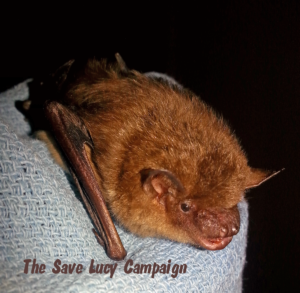
Hi everyone! I hope you all had a good week. Save Lucy’s President, Mrs. Sturges, found an interesting article that looks into the mystery of bat sounds. Scientists have found that some of the sounds that bats make resemble those of birds. Out of the 1,300 different bat species, the social vocalizations of about 50 have been studied. Of those 50, scientists discovered that about 20 of them are actually singing. It’s hard to hear bats singing if you go outside and watch them flying around. This is because a bat’s vocal range is in the ultrasonic range that is inaudible to human ears. In order to hear the bats’ sounds and research them further, scientists recorded bats singing and slowed them down. Their research has shown some similarities between bat and bird songs. Both bats and birds use the basal ganglia and prefrontal cortex parts of their brains to sing. Scientists believe that neural circuits also control bat vocals and how they are able to sing. Even though most bat species sing in an ultrasonic range, one species loves to sing in a range that humans can hear. The singing of the Greater Sac-Winged bat can be heard for miles. If you would like to read more about bats singing, you can find the article here. And now for a public service announcement. Daylight Savings Time begins on Sunday. Don’t forget to move your clocks 1 hour ahead before you go to bed tonight.
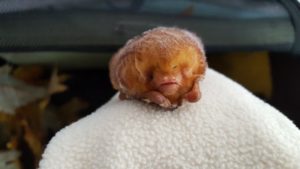
Hi everyone! I hope you all had a good week! I was home sick all week, so I didn’t really do much. I read an article about a new study being worked on by engineers at the University of British Columbia. The researchers are studying bat flight to help them develop better drones and other aerial vehicles. First the engineers built an aluminum bat wing and putting it in a wind tunnel. They then made a 3D computer model of the wing. They are studying how air flow affects the way a bat flies. Next, the engineers will make a physical model of a bat. This model will be used to study a bat in motion. Information learned will be used to optimize drone flight. They are hoping to make drones that will fly like automated bats with flapping wings. Groups of drones will be able to fly in a flock and will be used by businesses and emergency response. If you would like to read more, you can find the article here.
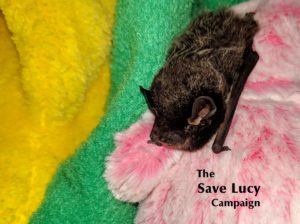
Hi everyone! I hope you all had a good week. I had a fabulous one because it was a holiday week and it snowed! Snow days are always especially fun! It’s been an exciting week at the Save Lucy Campaign. That’s because there is a cute new rescue. An adorable little Silver Haired bat was rescued a few days ago by the people working at the Hidden Oaks Nature Center in Annandale, VA. The bat is now being cared for by Save Lucy rehabilitators. The bat’s primary caretakers at Save Lucy have generously named him # 2019-19. Bats in rehabilitation are usually given numbers for names. However, seeing as no one wants their name to be a number, I think he needs a better name. Something sophisticated and grand. A name like Sherman! Since our newest addition is a Silver Haired bat, I thought I would write a little bit about them. They have beautiful black or, less commonly, dark brown fur. The hair on their back has lovely silver tips. These bats live throughout the United States and into Canada and Mexico. They haven’t been found anywhere above southeast Alaska though. One interesting fact about the Silver Haired bats is that they are one of the slowest flying bats in North America. If you would like to read more about silver haired bats in Alaska, you can do so here. I hope everyone has a fantastic week!

Hi everyone! I hope you all had a good week! I have been very busy with school and I’m looking forward to my three-day weekend. Recently, Franklin Junior High in St. Mary Parish in Louisiana has become a home to some fuzzy creatures. This is after Zachary High, the University of Louisiana at Monroe, and Gueydan High in Vermilion Parish became home to colonies of migrating Mexican free-tailed bats. A United Bat Control Owner went to Franklin Junior High to have a look. She says that it is most likely that the bats wanted to keep warm as they migrate north from Mexico to their spring homes. The bats decided to take up residency in the school’s gym. To protect the bats and the students, school was closed on the 14th and the 15th. School officials might have to close the school on Monday too, if they can’t get the bats out. Right now, their plan is to close all of the school’s doors and windows while the bats are all out hunting for tasty bugs. Then, before the bats come in again, they will seal up any openings to make sure the bats stay out in the wild where they belong. If you would like to read more, you can do so here.
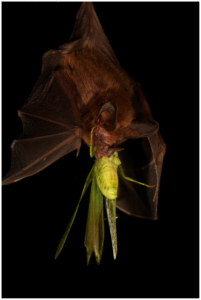
Hi everyone! I hope you all had a good week! I found a really interesting article about bats. The article is all about the importance of background noises. Some people think that background noise is a nuisance. Bats, however use the noises that they hear outside of their roosts to plan their outings. A group of researchers decided to test how background sounds affected a bat’s hunting habits. The scientists selected two bat colonies, one being the common big-eared bat (Micronycteris microtis) and the other the Pallas’s mastiff bat (Molossus molossus), and simulated the sounds of heavy downpours. When the bats heard the sounds, they stayed in their roosts! Bats don’t like flying in the rain because when their wings get wet, they have to use more energy to fly. Scientists don’t know exactly why else bats don’t like rain, but they believe it might jam their echolocation and their ability to navigate and find their dinner. The bats in the simulation didn’t like rain and decided to stay inside. For a comparison, the scientists also simulated the sound of normal forest sounds. The bats only stayed inside when the rain sounds were playing. The common big-eared bat also sent out a bat to investigate their environmental conditions. If you want to read more about this study, you can find it here.
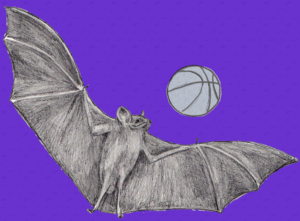
Hi everyone! I hope you all had a good week! I had a great one because I had almost no school! The polar vortex closed schools and caused delayed openings. We also got a little bit of snow. The teeny bit of snow caused them to close school on Friday. We have no school Monday because it’s a teacher work day. So, I have a 4-day weekend! And now for the bat news. At an NBA game between the San Antonio Spurs and the Brooklyn Nets, a few surprise guests appeared. A group of bats flew in from an unknown entry point and stopped the game. Security guards ran onto the court and started trying to catch them with a giant net! One member of the San Antonio Spurs, Manu Ginobili, has been known to catch these beautiful creatures. In a previous game of his, a Mexican free-tailed bat flew in and began flying around. Ginobili swatted the bat and gave it to an area attendant. If a creature, like a bat, does fly into your house or building, you should call someone trained to help in these situations. This could be Animal Control or a local wildlife facility. You should never take matters into your own hands unless absolutely necessary. Ginobili did not take the correct measures in safety, and had to get 16 rabies shots afterward. If you would like to watch the videos of the bats enjoying the basketball game, you can do so here. [Hitting a small flying animal in order to contain it is never appropriate. However, we are not sure why Mr. Ginobili had to have so many injections after his contact with the bat. Please be assured that normally, there are fewer injections. Don’t let fear of shots or needles keep you from seeking medical attention after a bite or scratch from […]
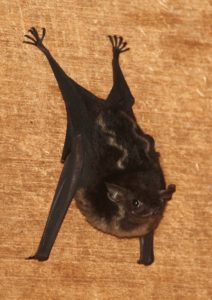
Hi everyone! I hope you all had a good week! Yesterday, a dam at an iron-ore mine in Brazil collapsed. Because of this disaster, I thought I would research a bat from Brazil. I found a very cute bat! It looks like a shrew that knows something you don’t. It’s called the Greater sac-winged bat. In addition to Brazil, these bats live in several other Central and South American countries. Their range is from central Mexico, through Central America, into South America. They live in the South American countries of Brazil, Bolivia, Guyana, Suriname, Guyane, and the Antillean islands. The Greater sac-winged bat has dark brown fur, and some have zig-zag stripes on their back. They have long noses and upper lips that are very mobile. They get their name from the small sacs or pouches on their wings. While grooming themselves, the males fill their sacs with drops of urine and glandular secretions. When they are trying to attract a female, the male will hover over her and flap the scent in their sacs toward her. They will also use this technique to ward off other bats from outside their territory. Another interesting fact about these bats is that their pups babble. They will vocalize calls and other sounds, but jumbled up just like a human baby’s babbles. This is the first mammal that is not a primate to be seen babbling. If you’d like to read more about the Greater sac-winged bat, you can find information here.
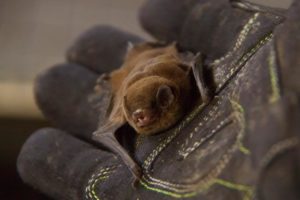
Hello everyone! I hope you all had a good week. I had a pretty good one because it started with a snow day. That’s right, it finally snowed! While it has been cold and wintery here in the US, people in Australia are in the middle of summer. And with Australian summers, come fires. Because there are so many fires burning in Australia right now, I decided to research an Australian bat. There is a cute little bat called the Chocolate Wattled Bat. Unlike most bats living in Australia, these bats are micro-bats! They have milk-chocolate brown fur, which is where they get their name. They also have a pink nose and a cute, squishy face. They like to roost under bark and in tree hollows in south-western Australia. Their diet consists of moths and beetles. And the Chocolate Wattled Bat will hibernate in the winter when the insects aren’t always around. Although south-western Australia isn’t known for being cold, it does get chilly. And with food scarce, they can’t eat enough to keep them warm. These bats do have a few predators including hawks, owls, cats, wildfires, and humans. If you would like to read more about the Chocolate Wattled Bat, you can find information here and here.
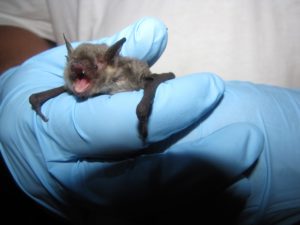
Hi everyone! I hope you all had a good week. It hasn’t been a very good week for National Parks and the plants and animals that live in them. That’s because the government shutdown continues. Many parks around the country are closed, but some remain open. Many of the parks that are open are suffering because of the lack of employees working at the park. Parks are being vandalized and trash is piling up. Sadly, vandals have even killed trees at Joshua Tree National Park. There are other effects of the shutdown too. Because government employees are not allowed to report to work, wildlife conservation and research has been put on hold. That means that government research on White-Nose Syndrome in bats has been halted. Luckily, not all government work has stopped. The US Fish and Wildlife Service has halted construction on 16 miles of Oklahoma Highway 16 between the town of Okay and the city of Wagoner. The work has been stopped to give investigators time to determine whether the construction will affect endangered Gray Bats in the area. Research is needed to determine whether or not sediment from the road construction has been affecting the quality of the water in the area. This could reduce the number of insects in the area, which would affect the bat’s ability to find food. If you would like to read more about this, you can find information here. I hope everyone has a good week. And, please, if you are fortunate enough to be allowed onto National Park land during this shutdown, take care of our parks. Please pick up your trash, stay on trails, and respect the plants and animals who live there.
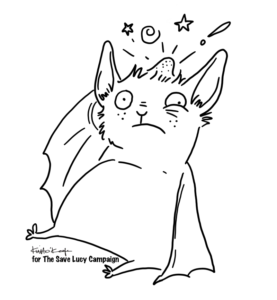
Hi everyone! I hope you all had a good week and a happy New Year! To kick off the new year, I thought I would make this a happy blog post. I found a lovely article about a recently recovered bat in the Salthaven West Wildlife and Education Center in Saskatchewan, Canada. He is an adorable Big Brown bat that will be released this May. He had very severe injuries when he came in, including a facial injury that rehabbers think came from a fight with another male bat. The injury had healed, but it left a bad scar. Because of this scar, his rehabbers named him Scarface. Despite his scary name, Scarface is very calm and happy for all the help he is receiving. He is staying in an enclosure much like the ones we have here at Save Lucy. The enclosure has a few other male bats, and some places for them to hang, hide and climb. The bats at the Center are kept awake all winter, even though they would be hibernating out in the wild. They get fed lots of mealworms to keep them happy and well fed. The bats at the Center are usually released back into the wild sometime in May, as long as they don’t still need help recovering from whatever brought them there in the first place. This year, Scarface will join the pack and fly back to his family. If you would like to read more about little Scarface, you can find the article here. I hope you all have a fantastic week! Happy New Year!









